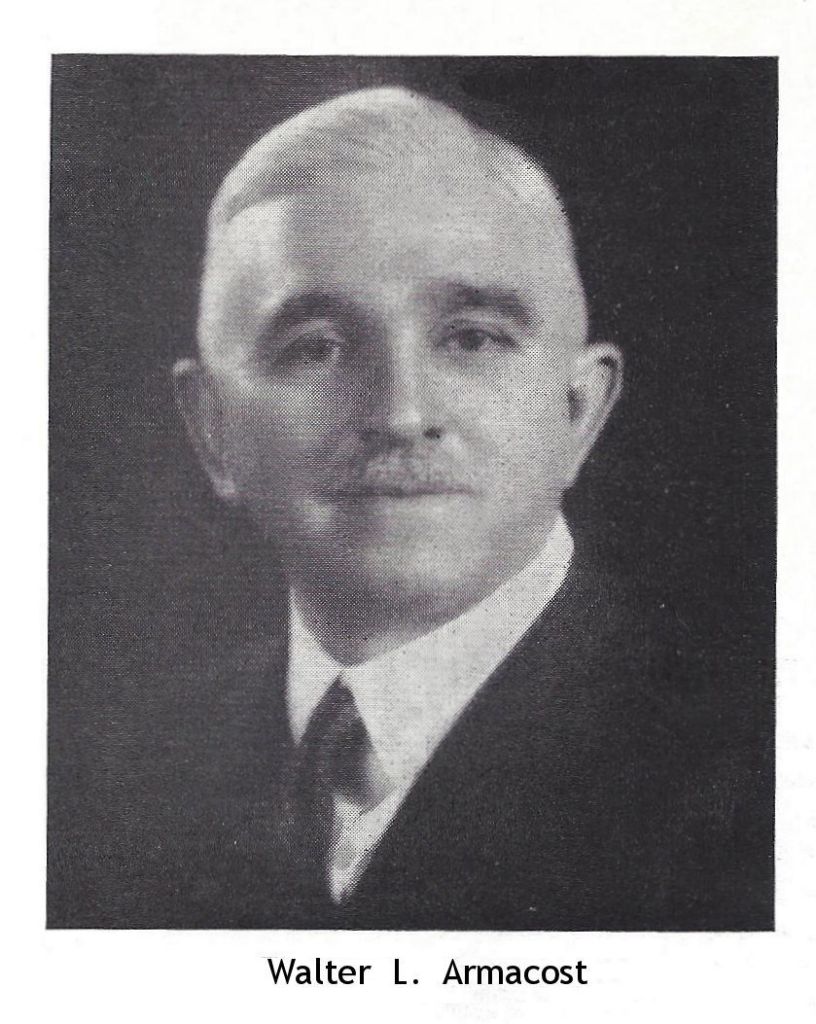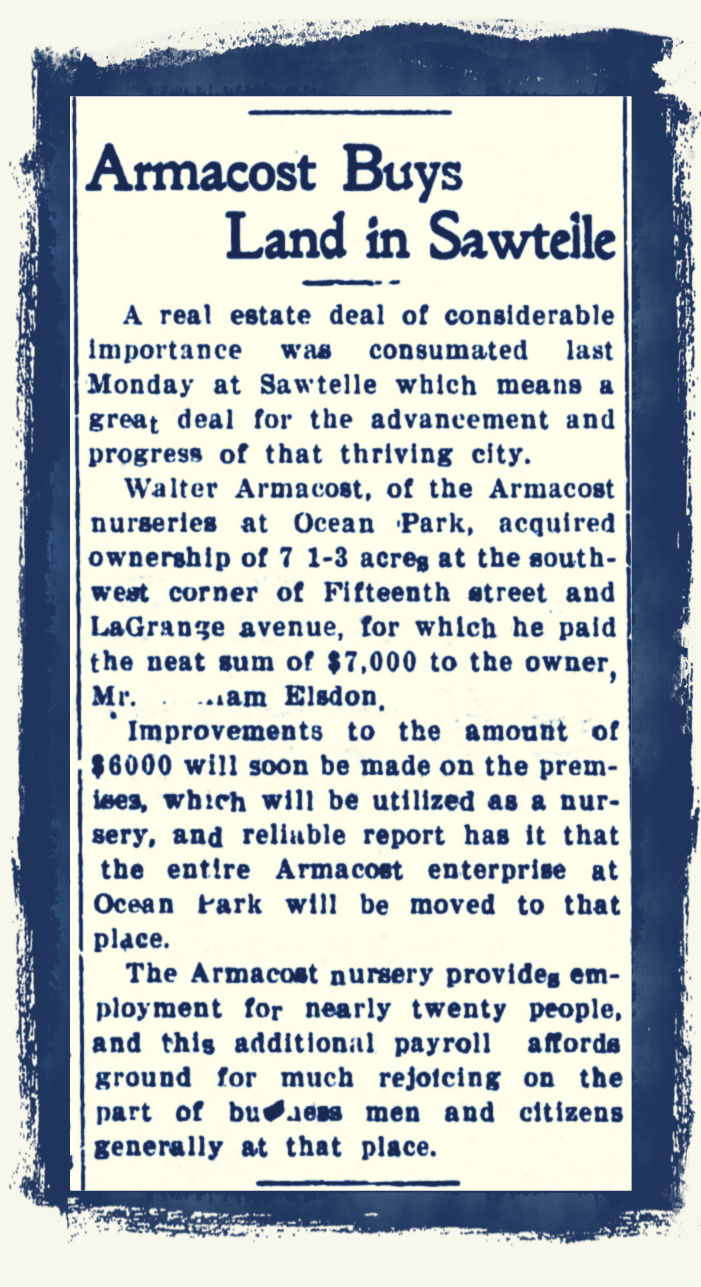
Picture of Walter Aramcost from the June 1953 AVSA African Violet Magazine -First American Horticulturalist To Introduce New Varieties of African Violets
Armacost avenue in West Los Angeles was named after the Nationally known Horticulturist and Sawtelle Pioneer Walter Armacost, whose residence and expansive Nursery was located on Armacost avenue and LaGrange Avenue. Today, the old Armacost Nursery & the original Walter Armacost residence have been demolished and replaced with commercial structures and small modest residential bungalows built in the early 1940s. The only remembrance that the “Armacost Dynasty” existed, is the street named “Armacost Avenue”.
See the Newspaper article titled “Listen Here” in the A.J. Stoner article that I posted at the following Link indicating that Armacost Avenue was named after Walter Armacost: https://sawtelle1897to1950.wordpress.com/about/1920s-the-naming-of-stoner-avenue/
Walter L. Armacost completed his High School education at the age of 16, taught school for 2 years then turned to his chosen field, serving his apprenticeship as a Horticulturalist in Baltimore Maryland and Jamestown, New York. Walter L. Armacost took Horace Greeley’s advice in 1903 and went to Los Angeles, California. There he was soon put in charge of E. J. Vauter’s fields of carnations. In October 1906 Walter Armacost formed a partnership with Louis Wolfley and they leased two acres of land where they grew various flowers and ferns. The following May 1907, Wolfley passed away and the business was then carried on by Walter Armacost as the Armacost Nurseries. In 1908, Armacost leased from Mr. Vauter’s part of his gardens at Sixth and Rose avenue, Ocean Park. There he had two small glass houses, some fern under lath and outdoor stock. and devoted his attention to the Rose avenue, Ocean Park property till 1911.
In 1911 he formed a partnership with Fred E. Royston and did business as Walter Armacost Company. Armacost and Royston invested in 37 Acres of property where they built an array of glass houses at Sawtelle, what is now generally the North East corner of Bundy drive and Olympic Blvd. Water, a vital component for growing Plants, was pumped up from the ground and stored in large Tanks. At that time, there was virtually nothing in that area except vacant acreage and farmland. He established the Los Angeles store of Walter Armacost Co. as his headquarters, on East Fourth street, so that both the growing (in Sawtelle) and selling (from the Los Angeles Store) aspects of the business were complete. The Walter Armacost Company was incorporated as Armacost and Royston Incorporated.
By the 1920s, Armacost had established himself as the largest wholesale florist business west of Chicago. His floral nursery was not just another small “Mom and Pop Nursery” that were typical in Sawtelle, West Los Angeles in the 1930s and 1940s, but His Nursery covered more than seven city blocks in Sawtelle California and his clients ranged from Canada to the north, Florida to the south, Boston to the east and Pacific coast cities at the west.
Armacost served as the last Mayor of the small independent city of Sawtelle California in 1922 when Sawtelle was annexed to the city of Los Angeles and who was 100% in favor of Sawtelle losing it’s independent City status and becoming part of the City of Los Angeles. On June 28, 1947 Walter Armacost passed away.
1911
The article below is a March 3, 1911 clipping from the Santa Monica Evening Outlook titled “Armacost buys Land in Sawtelle” courtesy of the Santa Monica Library.

1914
The article below Source: Santa Monica Daily Outlook April 01, 1914 courtesy of the Santa Monica Library.

1919
Below is an article retype and image dated July 10 1919 FLORISTS REVIEW…..Employees putting up the addition of 75,000 feet of Glass at the WALTER ARMACOST Nursery, Sawtelle, Cal.…The addition consists of seven houses, each 36×300 feet. It has been made necessary by the increasing business done by the firm. The Sawtelle Nursery is located on seventeen and one-half acres of land, nine acres of which are under lath for the culture of cut plumosus. The greenhouses comprise 200,000 feet of modern glass, and are devoted to roses, orchids.

The image below is an Advertisement on Easter Lily Plants from the Florist Review.

1920
The image below is a 1920 letter by Armacost copied from the Florist Review. The picture on the header of the letter is a birds eye view of the Walter Armacost and Fred E. Royston plant and glass greenhouses looking northeast toward SAWTELLE (from Bundy and Olympic).

1923
The image below is “Intimate Biographies of Bay District Personalities by Charles Warren”. The article mentioned that W. Armacost advocated the purchase of 40 acres for a playground (Later called Stoner playground) Armacost could easily be called the founder of Stoner playground……..Source: Santa Monica Outlook, May 09, 1923 courtesy of the Santa Monica Library. Click twice on the image to zoom in.
To zoom in, right click on the Image, then click on “open link in new window”. Click on the image to zoom in and use Vertical and Horizontal slide bars to Pan
1924
The City of Santa Monica (the city of Sawtelle’s western neighbor) was having an internal struggle around 1924, whether or not to consolidate to the City of Los Angeles (approve annexation to the city of L.A. as Sawtelle did in 1922). Walter Armacost who was the last Mayor of Sawtelle in 1922 and for whom Armacost Avenue is named after, gave a lecture to Santa Monica & Ocean Park as to why it would be in Santa Monica’s interest to approve annexation, which they never did. Strong opposition by Santa Monica’s leaders anti-annexation movement proved successful. Walter Armacost in the Evening Outlook Newspaper 12-13-1924 article responding Mr. Bleakley’s request, had printed in the Outlook Newspaper the high points of his lecture, “Why Santa Monica should consolidate”. I only bring out point one of the article, to state that Armacost said Sawtelle & Hollywood did not change their names after annexation to L.A. and at the time of the article, that was true. But just five years later, in 1929, the name “Sawtelle” got the boot and was replaced with the name “West Los Angeles”. The name “Hollywood” never got the shaft.

1927
The 1927 Santa Monica Street Directory lists Walter Armacost living at 2001 Armacost Avenue (corner at La Grange Avenue) in Sawtelle. The 1933 Santa Monica Street Directory lists Walter Armacost living at 1116 Carmelina Avenue which is north of Wilshire Blvd. Walter Armacost, a Sawtelle Pioneer, left the old Sawtelle area as a residence and Lived in the upper class district of Brentwood during & after the Depression of the 1930s and into the 1940s. The main Nursery was still located in the Sawtelle district for its orchid business but some other operations had expanded to the Chatsworth area in the San Fernando Valley.
1931
The image below is a photo of Mary Watkins seated in a greenhouse at the Armacost & Royston Nursery in West Los Angeles with an orchid in full bloom of the Cattleya Tityus family ready for display and sale. Source: UCLA Library Digital Collection 1931.

1937
Miss Betty Armacost daughter of Walter Armacost married Escell Price and the Reception was held at Walter Armacost’s House at 1116 S. Carmelina in Brentwood, north of Wilshire Blvd. Source Independent Newspaper, L.A. Library March 26, 1937.
1939

1940 – March
Armacost and Royston Inc. (Walter Armacost) sells 15 Acres of land to American Discount Corp. of Hollywood for the construction of 72 small bungalow Homes of which many exist today. The Nursery continued to operate headquartered on Armacost and La Grange avenues. Source Independent Newspaper, L.A. Library March 22, 1940.
April – 1940
Construction to Begin on 24 Homes and eventually on 72 lots bounded by Armacost, Westgate, Granville & Stoner Avenues, LaGrange & Missouri Avenues. Strict Racial restrictions were set up by the seller (Armacost and Royston) in 1940 when the 15 acre tract was sold to American Discount Corp. of Hollywood for the construction of 72 Homes. In just 10 years, some homes had been resold to racial minorities. In the early 1950s, I recall that on the Granville Tract, three homes had resold to families of Mexican ancestry, one Black and one Japanese. Source Independent Newspaper, L.A. Library April 12, 1940.

1946
The area in yellow was the Armacost & Royston Nursery in 1946, that included Glass Greenhouses. The red box was the original Walter Armacost residence in the 1920s. The green area is part of the Armacost Tract, new Housing development. The small boxes with the letter “D” in the green area are houses & the smaller boxes in the green area with the letter “A” are garages. I find the Sanborn Mapped images are difficult to read & are faded. This may or may not be a problem with low resolution scanning from the original document. Source: Digital Sanborn Map of West Los Angeles Apr. 1928-Dec. 1948, Los Angeles Central Library.


